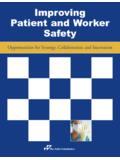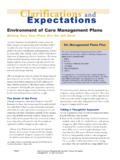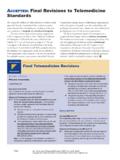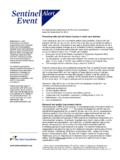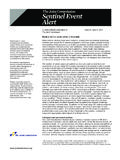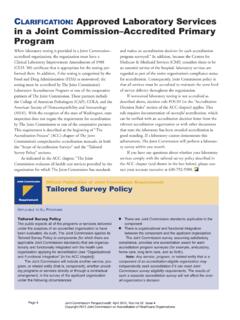Transcription of Optimizing smart infusion pump safety with DERS
1 2021 The Joint Commission | Division of Healthcare Improvement A complimentary publication of The Joint Commission Issue 63, April 14, 2021 Optimizing smart infusion pump safety with DERS Many medication errors can be prevented through safe medication practices;1 however, sometimes these errors including those involving smart infusion pumps are caused by a combination of human and technical risk factors, including fatigue, distraction, and drug library overrides, deficiencies or misuse. For example, a health care professional working on a busy hospital floor mistakenly enters an incorrect flow rate into a smart infusion pump s flow rate field while programming a medication infusion outside the drug library, resulting in a serious injury to the patient. smart infusion pumps combine computer technology and drug libraries to limit the potential for dosing errors.
2 Hospitalized patients commonly receive intravenous (IV) medications and fluids via smart infusion pumps, and errors involving the pumps occur each A study published in 2016 found that bypassing the smart infusion pump or the drug library accounted for about 10% of the total number of errors or policy violations relating to infusion smart pump errors can result in harm to patients that could be avoided by using built-in dose error reduction software (DERS).4 According to the Institute for Safe Medication Practices (ISMP), DERS refers to the integral computer software in smart infusion pumps intended to aid in prevention of infusion programming-related errors and warn users of pot ential over- or under-delivery of a medication or fluid by checking programmed doses/rates against facility-configurable preset limits specific to a medication/fluid, and to a clinical application ( , epidural administration) and/or location ( , neonatal intensive care unit , medical/surgical unit ).
3 Most United States hospitals have invested in smart infusion pumps5 with DERS, which have demonstrated their safety potential and have been on the market for 15 years. Still, many errors occur because health care organizations and clinicians are not Optimizing the use of DERS This Sentinel Event Alert describes actions health care organizations can take to reduce the risk of errors caused by the misuse of smart infusion pumps, especially er ro rs that can be avoided by the optimal use of DERS, which is expected practice according to The Joint Commission recognizes that safe medication management cannot be accomplished with technology alone. Please share this alert within your organization; the alert is directe d to clinicians using smart infusion pumps in all health care settings, especially nurses, physicians, pharmacists and anesthesia providers, and including clinical leadership, biomedical engineer s, and patient safety and risk officers.
4 Implementing DERS can improve safety DERS-equipped infusion pumps can store medication limits by care area, unit , location or patient population, with both hard and soft Hard stops are upper or lower limits set in the drug database that require the clinician to reprogram the pump to a value within DERS limits or to program the pump as a basic infusion outside the DERS. Soft stops are upper or lower limits that provide a warning prior to hitting the hard limit; the programming must be confirmed before the infusion can Published for Joint Commission accredited organizations and interested health care professionals, Sentinel Event Alert identifies specific types of sentinel and adverse events and high-risk conditions, describes their common underlying causes, and recommends steps to reduce risk and prevent future occurrences.
5 Accredited organizations should consider information in a Sentinel Event Alert when designing or redesigning processes and consider implementing relevant suggestions contained in the alert or reasonable alternatives. Please route this issue to appropriate staff within your organization. Sentinel Event Alert may be reproduced if credited to The Joint Commission. To receive by email, or to view past issues, visit Sentinel Event Alert, Issue 63 Page 2 2021 The Joint Commission smart infusion pumps with DERS are designed to reduce errors by keeping medication infusions within generally accepted ranges. The capability of DERS to store drug library information such as hospital-defined dose/concentration/rate limits and clinical advisories helps to avert errors and warn clinicians about potentially unsafe drug In other words, technology is only one of the tools that complements the design of a safe medication management system.
6 Among the most common programming errors associated with smart in fusion pumps are medication errors due to dose-rate confusion; mistakes with a decimal point, weight or unit of measure; and selecting the wro ng drug or dosing method in the drug By connecting wirelessly to electronic health record (EHR) systems, many smart infusion pumps can be auto programmed for a clinician s review and pharmacist s verification before starting an Integrating smart infusion pumps with an organization s EHR system results in benefits including a more complete and accurate library, which helps ensure DERS use when manual programming of a pump is ,10,11 A 2013 ECRI study that determined that 28% of infusion errors could have been prevented with DERS also found that 75% of the reported problems could have been averted with smart pump-EHR integration.
7 This integration also helps to ensure that: The right concentration, dose, rate, and weight/body sur face area are programmed, since these parameters are sent directly from the EHR. All infusions programmed with smart pump integration have a matching entry in the DERS smart infusion pumps can provide useful ongoing data for analysis to improve safety performance; these data help health care organizations to measure alert types and frequency, actions taken in response to alerts, the frequency of alert overrides, and compliance with using the drug Actions suggested by The Joint Commission Barriers to Optimizing the use of smart infusion pumps include limitations in infusion pump capabilities, alarm fatigue, availability of pumps, programming workflow, associated risks with secondary infusions, pump data analysis,5 and persistent deficie ncies related to library use and These deficiencies include omitting certain drugs and fluids (solutions)
8 From the library and failing to engage the library for available drugs and Additional barriers are related to usability and include confusing programming navigation, toggling between multiple screens, unintuitive selection keys and menus, and poor ergonomics that do not support human factors and the While understanding that the capabilities of smart infusion pumps and DERS vary within each organization, The Joint Commission suggests the following general actions that use a systems approach to help overcome these barriers and optimize the safe use of smart infusion pumps with DERS. 1. Leadership assigns responsibility by identifying a multidisciplinary project team or department (such as the pharmacy and therapeutic committee) responsible for smart infusion pump interoperability, including DERS, the oversight of drug library revisions or additions, infusion protocols, smart infusion pump maintenance and related 2.
9 Define a process to create, test, regularly engage with, and maintain a drug library. If a drug library is not designed and maintained well, DERS cannot operate optimally ( , garbage in, garbage out). Establish an interdisciplinary team to create, test and maintain a drug library, and to update it periodically at a frequency to be determined by the organization. ISMP recommends quarterly Perform independent double checks ( , performed separa te ly by two different people) when building the library for every drug entry in the library, including drug name, dosing units, concentration, dose limits and associated clinical Create a rapid approval process for any new formulary additions, with appropriate checks and balances to ensure all safety considerations are incorporated in the abbreviated process. Standardize the nomenclature for drug name, dose/dosing units ( , weight-based versus non-weight-based dosing; mcg/kg versus mg/kg), and dose rate (mg/kg/min versus mg/kg/hr) in the drug library.
10 Ensure that this Sentinel Event Alert, Issue 63 Page 3 2021 The Joint Commission nomenclature is consistent across the medication use process, including the EHR system, pharmacy infusion labels, and pharmacy IV workflow Establish subsets within the library tailored to specific clinical contexts or patient populations (such as pediatrics or oncology patients), hospital areas, or nursing units (such as critical care ).5 These subsets are often referred to as care areas. If possible, check the library s drugs, doses and ranges against other similar hospitals or organizations. When transferring patients to a different clinical unit , ensure the drug library care area/profile is appropriate for the receiving Standardize and limit the number of drug concentrations for continuous and intermittent infusions available in the drug library and ensure they are consistent within the EHR and pharmacy IV workflow Adoption of this safe practice will limit user selection mistakes in the drug library and help prevent overdosing errors.
